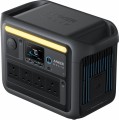Add to comparison |  |  |
|---|---|---|
| ANKER SOLIX C1000X | ANKER SOLIX F1200 | |
| Compare prices 3 | from £1,395.99 | |
| User reviews | ||
| TOP sellers | ||
4 USB A ports, 2 USB C ports. Car cigarette lighter. LiFePo4 battery. Backlight. UPS function. | ||
| In box | charging station | charging station |
| Rated power | 1800 W | 1500 W |
| Peak power | 2400 W | 3000 W |
| Output waveform | sinusoid (PSW) | sinusoid (PSW) |
| UPS function | ||
Outputs | ||
| Sockets (230 V) | 4 | 2 |
| USB A | 2 5В/2.4А 12 W | 4 5В/2.4А 12 W |
| USB C | 2 3 A, 5 A 100 W | 2 3 A, 5 A 100 W |
| Car cigarette lighter | ||
Inputs (station charging) | ||
| From solar panels | ||
| Input port XT60 | ||
| Add. ports | C13/14 (charging) | |
Battery and charging time | ||
| Connecting an additional battery | ||
| Battery type | LiFePO4 | LiFePO4 |
| Battery capacity | 1056 W*h | 1229 W*h |
| Charging cycles | 3000 | 3000 |
| Charging time (socket) ≈ | 58 min | 90 min |
| Charging time (solar panel) ≈ | 108 min | 246 min |
| Charging time (cigarette lighter) ≈ | 828 min | |
| Charging power (socket) | 1300 W | 1000 W |
| Charging power (solar panel) | 600 W | 300 W |
| Charging power (cigarette lighter) | 120 W | |
General | ||
| Smartphone synchronization | Bluetooth and WiFi | |
| PSU | built into the body | built into the body |
| Display | ||
| Backlight | ||
| Carrying handle | ||
| Operating temperature | 0 °C ~ +40 °C | 0 °C ~ +40 °C |
| Dimensions | 267x376x205 mm | 288x463x237 mm |
| Weight | 12.9 kg | 19.9 kg |
| Warranty | 5 years | 5 years |
| Added to E-Catalog | august 2024 | december 2022 |
ANKER SOLIX C1000X and ANKER SOLIX F1200 are powerful charging stations but have some key differences. The C1000X has a rated power of 1800W and a peak power of 2400W, while the F1200 has a lower rated power of 1500W but a higher peak power of 3000W. The C1000X offers 4 sockets at 230V and 2 USB A ports, while the F1200 has 2 sockets at 230V and 4 USB A ports, which may be more convenient for users needing more USB outputs. Both devices use LiFePO4 batteries with a charge cycle of up to 3000 times, but the C1000X has a capacity of 1056Wh, whereas the F1200 has 1229Wh, giving the F1200 an advantage in operating duration. The charging time from an outlet for the C1000X is about 58 minutes, while the F1200 requires about 90 minutes. Both devices have a built-in power supply and support solar charging, but the C1000X charges faster from the grid. Overall, the choice between them depends on your power needs and the number of outputs.